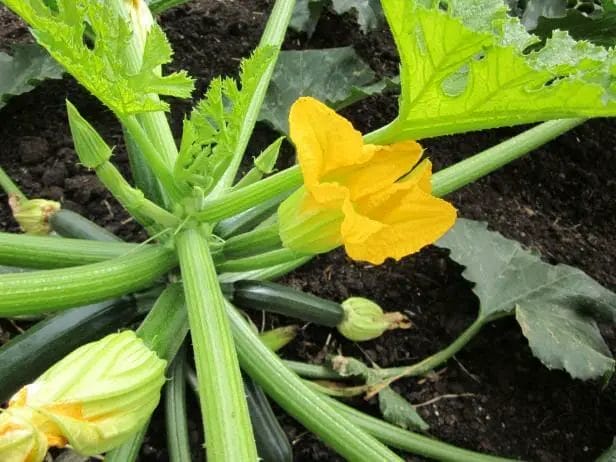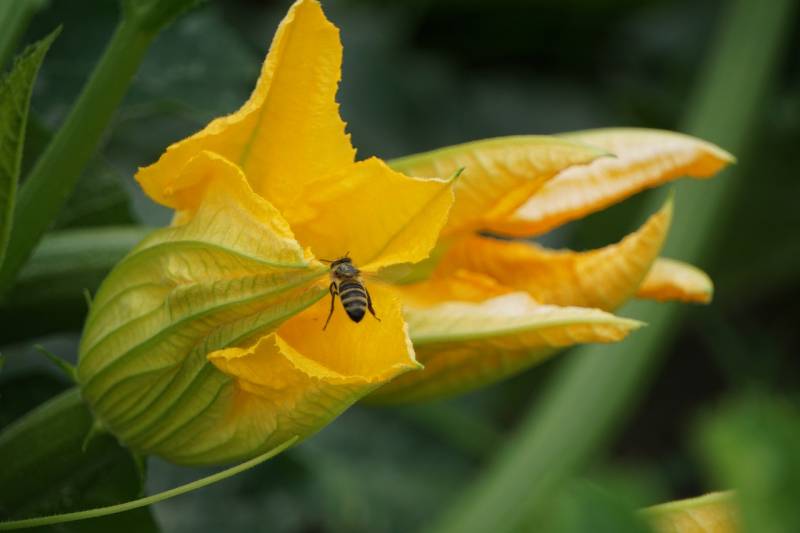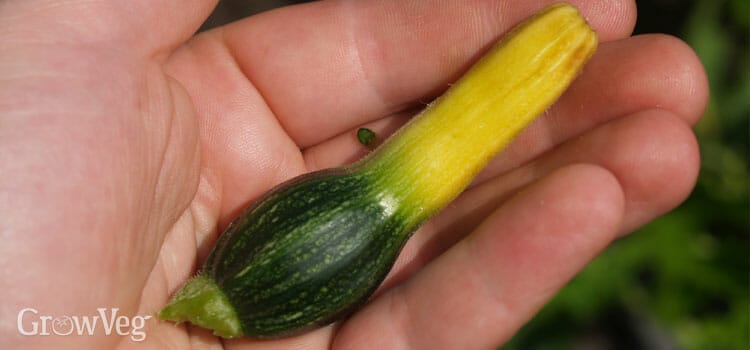If you find that your zucchini plant only has male flowers, it’s important to understand the reason behind this. Male flowers on zucchini plants tend to appear before the female flowers, which are necessary for fruit production. The presence of only male flowers could be due to various factors such as plant immaturity or stress. Lack of pollinators can also lead to an abundance of male flowers. Understanding the reasons behind this can help you take appropriate steps to ensure a healthy and fruitful zucchini harvest.

Factors Influencing Male Flower Dominance in Zucchini Plants
Zucchini plants, scientifically known as Cucurbita pepo, are monoecious plants, meaning they produce both male and female flowers on the same plant. However, in some cases, zucchini plants may exhibit male flower dominance, where the majority of the flowers that develop are male. This can have significant implications for fruit production and overall plant health. In this section, we will explore the various factors that can influence male flower dominance in zucchini plants.
1. Genetic Factors
Genetics play a crucial role in determining the sex expression of zucchini plants. The plant’s genetic makeup can influence its tendency to produce more male flowers compared to female flowers. This can be seen in certain zucchini cultivars that are bred specifically for their high male flower production, which can be advantageous for commercial seed production but may not be desirable for home gardeners focused on fruit production.
2. Environmental Factors
Environmental conditions have a significant impact on the sex expression of zucchini plants. Temperature, light intensity, and humidity levels can all influence the ratio of male to female flowers. Zucchini plants tend to produce more male flowers in conditions of high temperature and intense light, while cooler temperatures and lower light levels promote the development of female flowers. Additionally, high humidity can contribute to the development of more male flowers.
3. Nutrient Availability
The availability of nutrients in the soil can affect the sex expression of zucchini plants. Nitrogen, phosphorus, and potassium levels, in particular, can play a role in determining the ratio of male to female flowers. A deficiency or imbalance of these nutrients can lead to a higher proportion of male flowers. It is important to ensure that the soil is properly fertilized and that the necessary nutrients are provided in adequate quantities to promote balanced flower development.
4. Pollinator Activity
Zucchini plants rely on insect pollinators, such as bees, for the transfer of pollen between male and female flowers. The presence and activity of pollinators can influence the sex expression of zucchini plants. If there is a lack of pollinators in the vicinity, the plants may produce more male flowers to increase the chances of successful pollination. Ensuring a habitat-friendly environment for pollinators and providing attractive flowering plants nearby can help maintain a balanced ratio of male to female flowers in zucchini plants.
5. Plant Age and Size
The age and size of zucchini plants can also impact the dominance of male flowers. Young and small plants are more likely to produce a higher proportion of male flowers compared to older and larger plants. As the plant matures and establishes a larger root system, the balance between male and female flowers tends to even out. Therefore, it is important to give zucchini plants sufficient time to grow and develop before expecting a balanced flower production.
6. Seasonal Variation
Seasonal variation can influence the sex expression of zucchini plants. In the early stages of the growing season, zucchini plants may produce a higher proportion of male flowers as a strategy to maximize pollination and increase the chances of successful fruit set. As the season progresses, the plants may start to produce more female flowers to ensure the continuity of fruit production. Understanding the natural seasonal patterns of zucchini plants can help gardeners anticipate and manage male flower dominance.
7. Plant Stress
Stressful conditions, such as drought, excessive heat, or pest infestations, can trigger male flower dominance in zucchini plants. In response to unfavorable environmental or physiological conditions, the plants may prioritize the production of male flowers over female flowers as a survival strategy. Providing optimal growing conditions, including consistent watering, protection from extreme temperatures, and proactive pest management, can help reduce plant stress and promote a more balanced flower production.
In summary, several factors can influence male flower dominance in zucchini plants. Genetic factors, environmental conditions, nutrient availability, pollinator activity, plant age and size, seasonal variation, and plant stress all play a role in determining the ratio of male to female flowers. By understanding and managing these factors, gardeners can encourage a balanced flower production and maximize fruit yield in zucchini plants.

How to Promote Female Flower Production in Zucchini Plants
Zucchini plants are well-known for their delicious fruits, but did you know that the female flowers play a crucial role in the production of these tasty vegetables? Female flowers are the ones that develop into the zucchini fruits, while male flowers are responsible for pollination. In order to ensure a bountiful harvest of zucchinis, it is essential to promote the production of female flowers in your zucchini plants. In this section, we will discuss various techniques and tips to help you boost female flower production in your zucchini plants.
1. Provide Optimal Growing Conditions
Creating the right environment for your zucchini plants is the first step in promoting female flower production. Zucchinis thrive in full sunlight, so make sure to plant them in a location that receives at least 6-8 hours of direct sunlight every day. Additionally, zucchini plants require well-draining soil with a pH level between 6 and 7. Amend the soil with organic matter, such as compost, to ensure proper drainage and nutrient availability.
2. Avoid Over-Fertilization
While it is important to provide your zucchini plants with adequate nutrients, over-fertilization can actually hinder female flower production. Excessive nitrogen, in particular, can promote the growth of lush foliage at the expense of flower development. Use a balanced fertilizer with a lower nitrogen content to promote overall plant health without compromising female flower production.
3. Hand Pollination
If your zucchini plants are not producing enough female flowers, you can help facilitate pollination by hand. Female flowers have a swollen bulb at the base, while male flowers have a slender stem. Early in the morning when the flowers are fully open, gently remove a male flower from the plant and transfer its pollen to the stigma of a female flower. This manual pollination process will increase the chances of fruit development.
4. Prune the Plant
Pruning your zucchini plant can redirect its energy towards female flower production. Remove any excessive foliage or lateral branches, as they can divert nutrients away from flower development. Focus on maintaining a healthy and open plant structure to allow for better air circulation and light penetration, which will promote the growth of female flowers.
5. Adequate Watering
Proper watering is crucial for the growth and development of zucchini plants. Keep the soil consistently moist but not waterlogged. Water deeply and regularly to ensure the roots have access to water, especially during hot and dry periods. Inconsistent watering can cause stress to the plant, resulting in poor flower production.
6. Introduce Beneficial Insects
Some insects, such as bees and butterflies, play a key role in pollinating zucchini plants. Encourage their presence in your garden by planting flowers that attract these beneficial insects, such as lavender, marigold, or daisies. These pollinators will help increase the chances of successful pollination and, in turn, boost female flower production.
7. Adjust Environmental Factors
Environmental factors such as temperature and humidity can also impact female flower production. Zucchini plants prefer temperatures between 70 and 90 degrees Fahrenheit for optimal growth and flower development. If the temperatures consistently exceed these ranges, consider providing shade or using row covers to protect the plants from excessive heat. Similarly, maintaining proper humidity levels can prevent flower drop and promote female flower formation.
8. Time Your Planting
Proper timing is essential when it comes to zucchini plant growth and female flower production. Start planting your zucchini seeds or transplants after the last frost date in your area. This will ensure that the plants have enough time to establish themselves and produce female flowers before the end of the growing season. Additionally, staggered planting every few weeks can help prolong the production of female flowers and extend your harvest.
In summary, promoting female flower production in zucchini plants requires creating optimal growing conditions, avoiding over-fertilization, hand pollination, pruning, adequate watering, introducing beneficial insects, adjusting environmental factors, and timing your planting. By following these techniques and tips, you can maximize the yield of delicious zucchinis from your garden.

The Importance of Pollination in Maximizing Zucchini Yield
Pollination plays a crucial role in the growth and development of plants, including zucchini. It is the process by which pollen is transferred from the male reproductive part of a flower (anther) to the female reproductive part (stigma) of the same or a different flower. This transfer of pollen is necessary for fertilization and the production of fruits.
In the case of zucchini plants, proper pollination is essential for maximizing yield. Zucchini plants produce both male and female flowers on the same plant. The male flowers typically appear first and produce pollen, while the female flowers develop a fruit-bearing ovary at the base. For optimal fruit production, it is crucial to have successful pollination, leading to fertilization and the development of healthy zucchini fruits.
There are primarily two types of pollination that can occur in zucchini plants: self-pollination and cross-pollination.
Self-Pollination
Self-pollination happens when the pollen from the anther of a flower is transferred directly to the stigma of the same flower or a different flower on the same plant. Zucchini plants have both male and female flowers, and the presence of both types of flowers on the same plant promotes self-pollination. However, self-pollination alone may not always result in optimal fruit production.
One of the factors affecting self-pollination success is the timing of flower opening. Zucchini flowers are typically open for a short period, usually just for one day. Therefore, adequate timing is crucial for successful self-pollination. Additionally, environmental factors such as wind and humidity can influence the transfer of pollen within the same plant.
Cross-Pollination
Cross-pollination occurs when the pollen from the anther of one zucchini plant is transferred to the stigma of a flower on a different plant. While zucchini plants are primarily self-fertile, cross-pollination can enhance fruit production and genetic diversity. It allows for the exchange of genetic material between different zucchini plants, which can result in stronger and more productive offspring.
Pollinators, such as bees and other insects, play a vital role in the cross-pollination of zucchini plants. As they move from flower to flower in search of nectar and pollen, they inadvertently transfer pollen between plants, facilitating fertilization and fruit development. It is therefore important to create an environment that attracts pollinators to your zucchini plants, such as planting flowers that provide nectar and maintaining a pesticide-free garden.
Maximizing Zucchini Yield through Pollination
In order to maximize zucchini yield through pollination, there are a few strategies that can be employed:
- Planting multiple zucchini plants: By planting several zucchini plants in close proximity, you increase the chances of cross-pollination and enhance fruit production.
- Encouraging pollinator activity: Create a pollinator-friendly garden by planting a variety of flowers that attract bees and other beneficial insects. Avoid using pesticides that can harm or deter pollinators.
- Hand pollination: If pollinator activity is low or you want to ensure effective pollination, you can manually transfer pollen from the male flower to the female flower using a small brush or cotton swab. Gently brush the inside of the male flower to collect pollen, then transfer it to the stigma of the female flower.
- Timing: Keep track of when the flowers open and make sure to check them daily. Early morning is usually the best time to observe open flowers and perform any necessary pollination.
In summary, pollination is vital for maximizing zucchini yield. Both self-pollination and cross-pollination contribute to the successful development of zucchini fruits. By understanding and utilizing the importance of pollination, you can ensure healthy plant growth and abundant zucchini harvests.
Troubleshooting Male Flower Abundance in Zucchini Plants
Zucchini plants are known for their prolific production of both male and female flowers. However, sometimes gardeners may notice an abundance of male flowers without a proportional number of female flowers, which can hinder fruit production. In this section, we will explore the possible causes of this issue and provide troubleshooting tips to help you address it.
Potential Causes
There are several factors that can contribute to an overabundance of male flowers in zucchini plants. Understanding these causes is crucial in order to implement the appropriate solutions. Here are some potential reasons:
1. Environmental Factors
Environmental conditions play a significant role in flower production. High temperatures, especially during the early stages of plant development, can lead to an increase in male flowers. Other environmental factors such as insufficient sunlight or inadequate pollination may also contribute to this issue.
2. Nutrient Imbalance
An imbalance in nutrients, particularly nitrogen, can result in excessive vegetative growth and an overproduction of male flowers. It is important to ensure that your zucchini plants receive a balanced fertilizer or compost that provides adequate nutrition.
3. Lack of Pollinators
Zucchini plants rely on pollinators, such as bees, to transfer pollen from male to female flowers. If there is a shortage of pollinators in your garden, the female flowers may not be adequately pollinated, leading to a higher ratio of male flowers.
Troubleshooting Tips
Now that we have identified possible causes, let’s explore some troubleshooting tips to address the issue of male flower abundance:
1. Provide Adequate Sunlight
Zucchini plants require at least 6-8 hours of direct sunlight per day. Ensure that your plants are positioned in a location that receives sufficient sunlight to promote proper flower development.
2. Maintain Optimal Temperature
Avoid exposing your zucchini plants to extreme heat during the early stages of growth. If necessary, provide shade or use mulch to regulate soil temperature. This can help prevent an overproduction of male flowers.
3. Hand Pollination
If you suspect a lack of pollinators in your garden, you can manually pollinate the female flowers. Gently transfer pollen from the male flowers to the female flowers using a small brush or cotton swab. This ensures proper fertilization and fruit set.
4. Adjust Nutrient Levels
Regularly monitor the nutrient levels in your soil and adjust them as necessary. Use a balanced fertilizer or organic compost that provides essential nutrients in the right proportions. Avoid excess nitrogen, as it can promote vegetative growth at the expense of flower development.
5. Avoid Overwatering
Overwatering can lead to poor root health and nutrient imbalances. Ensure that the soil is well-draining and only water the plants when the top inch of soil feels dry. Adequate moisture levels promote healthy flower production.
6. Introduce Pollinator-friendly Plants
Encourage pollinators to visit your garden by planting a variety of pollinator-friendly flowers nearby. This can help attract bees and other beneficial insects, improving the chances of successful pollination in your zucchini plants.
Summary
Male flower abundance in zucchini plants can be a common issue that affects fruit production. By understanding the potential causes and implementing the troubleshooting tips mentioned above, you can increase the chances of achieving a balanced ratio of male and female flowers. Remember to provide optimal growing conditions, ensure proper pollination, and maintain a well-balanced nutrient regimen for your zucchini plants. With these measures in place, you can enjoy a bountiful harvest of zucchinis.
FAQs
Q: Why does my zucchini plant only have male flowers?
Male flowers usually appear first on zucchini plants to attract pollinators. Female flowers, which produce fruit, typically follow a week or two later. If your plant only has male flowers, it may be due to young age, lack of pollinators, high temperatures, or nutrient imbalances. Patience and providing proper growing conditions should eventually result in female flowers appearing.
Conclusion:
In conclusion, if your zucchini plant is only producing male flowers, there is no need to worry. It is a natural occurrence in the plant’s reproductive cycle. Male flowers typically appear first to attract pollinators, such as bees, before the female flowers develop. This is a common adaptation in many plants, including zucchini, to ensure successful pollination and fruit production. As the plant matures, you will start to see female flowers, which will eventually lead to the formation of zucchini fruits. So, be patient and enjoy the beauty of the male flowers while you wait for the arrival of the female flowers and your bountiful zucchinis!

